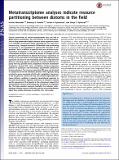| dc.contributor.author | Alexander, Harriet | |
| dc.contributor.author | Jenkins, Bethany D. | |
| dc.contributor.author | Rynearson, Tatiana A. | |
| dc.contributor.author | Dyhrman, Sonya T. | |
| dc.date.accessioned | 2015-10-01T12:46:13Z | |
| dc.date.available | 2015-10-01T12:46:13Z | |
| dc.date.issued | 2015-04 | |
| dc.date.submitted | 2014-11 | |
| dc.identifier.issn | 0027-8424 | |
| dc.identifier.issn | 1091-6490 | |
| dc.identifier.uri | http://hdl.handle.net/1721.1/99118 | |
| dc.description.abstract | Diverse communities of marine phytoplankton carry out half of global primary production. The vast diversity of the phytoplankton has long perplexed ecologists because these organisms coexist in an isotropic environment while competing for the same basic resources (e.g., inorganic nutrients). Differential niche partitioning of resources is one hypothesis to explain this “paradox of the plankton,” but it is difficult to quantify and track variation in phytoplankton metabolism in situ. Here, we use quantitative metatranscriptome analyses to examine pathways of nitrogen (N) and phosphorus (P) metabolism in diatoms that cooccur regularly in an estuary on the east coast of the United States (Narragansett Bay). Expression of known N and P metabolic pathways varied between diatoms, indicating apparent differences in resource utilization capacity that may prevent direct competition. Nutrient amendment incubations skewed N/P ratios, elucidating nutrient-responsive patterns of expression and facilitating a quantitative comparison between diatoms. The resource-responsive (RR) gene sets deviated in composition from the metabolic profile of the organism, being enriched in genes associated with N and P metabolism. Expression of the RR gene set varied over time and differed significantly between diatoms, resulting in opposite transcriptional responses to the same environment. Apparent differences in metabolic capacity and the expression of that capacity in the environment suggest that diatom-specific resource partitioning was occurring in Narragansett Bay. This high-resolution approach highlights the molecular underpinnings of diatom resource utilization and how cooccurring diatoms adjust their cellular physiology to partition their niche space. | en_US |
| dc.description.sponsorship | American Society for Engineering Education. National Defense Science and Engineering Graduate Fellowship | en_US |
| dc.language.iso | en_US | |
| dc.publisher | National Academy of Sciences (U.S.) | en_US |
| dc.relation.isversionof | http://dx.doi.org/10.1073/pnas.1421993112 | en_US |
| dc.rights | Article is made available in accordance with the publisher's policy and may be subject to US copyright law. Please refer to the publisher's site for terms of use. | en_US |
| dc.source | National Academy of Sciences (U.S.) | en_US |
| dc.title | Metatranscriptome analyses indicate resource partitioning between diatoms in the field | en_US |
| dc.type | Article | en_US |
| dc.identifier.citation | Alexander, Harriet, Bethany D. Jenkins, Tatiana A. Rynearson, and Sonya T. Dyhrman. “Metatranscriptome Analyses Indicate Resource Partitioning Between Diatoms in the Field.” Proc Natl Acad Sci USA 112, no. 17 (April 13, 2015): E2182–E2190. | en_US |
| dc.contributor.department | Joint Program in Oceanography/Applied Ocean Science and Engineering | en_US |
| dc.contributor.department | Massachusetts Institute of Technology. Department of Biology | en_US |
| dc.contributor.department | Woods Hole Oceanographic Institution | en_US |
| dc.contributor.mitauthor | Alexander, Harriet | en_US |
| dc.relation.journal | Proceedings of the National Academy of Sciences | en_US |
| dc.eprint.version | Final published version | en_US |
| dc.type.uri | http://purl.org/eprint/type/JournalArticle | en_US |
| eprint.status | http://purl.org/eprint/status/PeerReviewed | en_US |
| dspace.orderedauthors | Alexander, Harriet; Jenkins, Bethany D.; Rynearson, Tatiana A.; Dyhrman, Sonya T. | en_US |
| dc.identifier.orcid | https://orcid.org/0000-0003-1308-8008 | |
| mit.license | PUBLISHER_POLICY | en_US |
| mit.metadata.status | Complete | |
